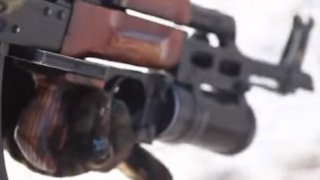Want To Shoot a Grenade Out of an AK-47? Russia Has the Answer
It's the “squad leader’s artillery.”
Here's What You Need To Know: The GP-25 has provided long-range firepower to infantrymen since the 1970s.
The U.S. military’s M203 underbarrel grenade launcher is an iconic weapon. It is commonly seen on rifles from the 1970s forward, it replaced the Vietnam-era M79 stand-alone grenade launcher as the “squad leader’s artillery,” allowing a skilled infantryman to eliminate enemy concentrations and hardpoints without needing to call for fire.
The benefits of such a weapon were not lost on military planners in the Soviet Union. While accounts on when work began differ, the project to develop a grenade launcher meant to be attached to a rifle is generally accepted to have begun in the early to mid-1970s.
The work was assigned to the ЦКИБ СОО design bureau in Tula under the direction of V. N. Telesh, with the Moscow state enterprise ГНПП «Прибор» in Moscow becoming involved later. Tests of the new weapon concluded in 1978, and the weapon was accepted into service as the GP-25 “Костер” (Bonfire), with the GRAU index 6Г15.
The GP-25 initially entered service with only the VOG-25 point-detonating high-explosive round, but in 1979 the VOG-25P airburst round entered service. In Russian service, the GP-25 has been attached to the AKM, AK-74, and AK-74M and continues to be the most common grenade launcher in use today. More advanced launchers like the GP-30 and GP-34 have only been procured in small numbers.
The GP-25 shares many key differences from its American counterpart, the M203. The largest difference is the ammunition, which is caseless and muzzle-loading. This theoretically improves the rate of fire and eliminates the need to deal with shell casings but can prove dangerous to the operator.
The GP-25 has a double-action trigger, where the pull both cocks the hammer and releases it. This makes it easier to attempt a second-strike on a misfired grenade. The M203’s trigger is single action, the user must recock and reload the launcher before trying to shoot again.
It also features a quadrant sight, which gives the GP-25 an effective aimed range of the GP-25 of 400 meters, further than the 250 meters of the M203 with the standard issue leaf sight. The quadrant sight also features two “mortar” or high-elevation sight settings that allow for plunging fire. It also features the ability to drift the front sight to the left and right to compensate for wind. M203s have been fitted with quadrant sights and sights that give it high-elevation capability, but the 250m leaf sight was the standard during the Cold War.
Russian sites often emphasize the effectiveness of the GP-25’s VOG-25 ammunition compared to the various 40mm rounds used by American launchers. While the VOG-25’s projectile does contain more explosive filler, it’s unlikely to achieve the 3-4 times increase in effectiveness claimed by the site.
However, the GP-25 has some drawbacks compared to the M203. As said before, the GP-25’s muzzle loading nature makes it risky to use in comparison to the M203. While the GP-25 has some mechanical safeties in place to prevent firing of grenades during the loading process, they have been to known to fail. There are photos of soldiers with a VOG-25 grenade embedded in their hand as a result of a misfire during the loading process.
Also, the GP-25’s retention of grenades in the chamber is weak. It relies on a single round “fixator” pin latching onto a groove in the grenade. Grenades have been known to fall out when the barrel is tilted downwards. This limits its utility firing downwards from elevated positions.
In other situations, the grenades can become stuck in the barrel and hard to remove safely with the built in extractor. None of these problems are present in the M203 due to its breech loading nature.
All of these issues are resolved in the newer GP-34, which features improved grenade retention, more safeties, and a more beefy extractor, but the GP-34 has only seen use with elite units in the Russian army and paramilitary forces.
While Russian sites consistently state that the GP-25 has a faster rate of fire than the M203, this doesn’t hold up to scrutiny. They consistently give the rate of fire for the GP-25 as 4-5 rounds per minute and the GP-34 at 5-6 rounds per minute. To contrast, US Army TM 3-22.31 lists the rate of fire at 5-7 rounds per minute, faster than the GP-25 and on par with the GP-34.
Overall, the GP-25 and M203 were fairly evenly matched grenade launchers during the Cold War. The GP-25 has a more advanced sighting system and comes with more accessories such as a recoil pad and reinforced recoil spring guide, but the M203 is generally safer, faster firing, more reliable, and has a wider range of ammunition.
Information on the GP-25’s development was taken from С. Б. Монетчиков’s История русского автомата, ГЛАВА 3 Создание автоматно-гранатометного комплекса.
Charlie Gao studied Political and Computer Science at Grinnell College and is a frequent commentator on defense and national security issues.
This first appeared in April 2019.
Image: A GP-25 grenade launcher. 31 January 2016. Wikimedia/Gennady Dubovoy. Creative Commons Attribution 3.0 Unported license.

